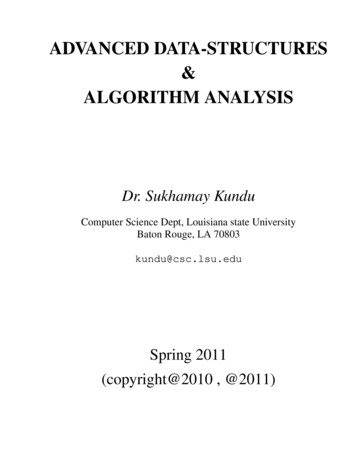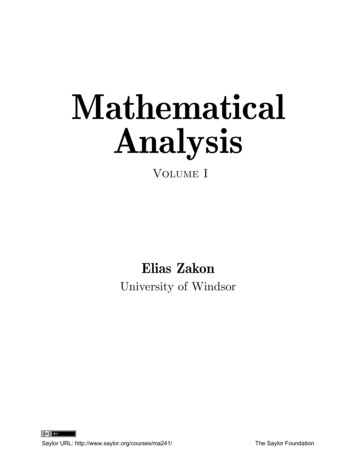
Transcription
ADVANCED DATA-STRUCTURES&ALGORITHM ANALYSISDr. Sukhamay KunduComputer Science Dept, Louisiana state UniversityBaton Rouge, LA 70803kundu@csc.lsu.eduSpring 2011(copyright@2010 , @2011)
1.2ROLE OF DATA-STRUCTURESIN COMPUTATIONMakes Computations Faster: Faster is better. (Another way to make computations faster is touse parallel or distributed computation.)Three Basic Computation Steps:Computation Sequence of Computation StepsExternalInputProgram: (1) Locate/Access data-values (inputs to a step)(2) Compute a value (output of a step)(3) Store the new valueExternalOutputAlgorithm DataStructure Implementation.Algorithm The basic method; it determines the data-items computed. Also, the order in which those data-items are computed (andhence the order of read/write data-access operations). Data structures Supports efficient read/write of data-items used/computed.Total Time Time to access/store data Time to compute data.Efficient Algorithm Good method Good data-structures( Good Implementation)Question: ? What is an efficient program? ? What determines the speed of an Algorithm? ? A program must also solve a "problem". Which of the three partsalgorithm, data-structure, and implementation embodies this?
1.3ALGORITHM OR METHODvs. DATA STRUCTUREProblem: Compute the average of three numbers.Two Methods:(1)(2)aver (x y z)/3.aver (x/3) (y/3) (z/3). Method (1) superior to Method (2); two less div-operations. They access data in the same order: 〈x, y, z, aver〉. Any improvement due to data-structure applies equally well toboth methods.Data structures:(a)Three variables x, y, z.(b)An array nums[0.2]. This is inferior to (a) because accessing an array-item takesmore time than accessing a simple variable. (To accessnums[i], the executable code has to compute its addressaddr(nums[i]) addr(nums[0]) i*sizeof(int), whichinvolves 1 addition and 1 multiplication.) When there are large number of data-items, naming individual data-items is not practical. Use of individually named data-items is not suitable when avarying number of data-items are involved (in particular, ifthey are used as parameters to a function).A Poor Implementation of (1): Using 3 additions and 1 division.a x y; //uses 2 additional assignmentsb a z;aver b/3;
1.4LIMITS OF EFFICIENCYHardware limit: Physical limits of time (speed of electrons) and space (layout ofcircuits). This limit is computation problem independent.From 5 mips (millions of instructions per sec) to 10 mips is animprovement by the factor of 2.One nano-second 10 9 (one billionth of a second); 10 mips 100 ns/instruction.Software limit: Limitless in a way, except for the inherent nature of the problem.That is, the limit is problem dependent.Sorting Algorithm A1: O(n. log n) timeSorting Algorithm A2: O(n2 ) time(n number of items sorted)A1 is an improvement over A2 by the factorn2n as n .n. log n log n O(n. log n) is the efficiency-limit for sorting Algorithms.
1.5MEASURING PERFORMANCEAnalytic Method: Theoretical analysis of the Algorithm’s time complexity.Empirical Methods: Count the number of times specific operations are performed byexecuting an instrumented version of the program. Measure directly the actual program-execution time in a run.Example of Instrumentation:Original code:if (x y) small x;else small y;Instrumentd code:countComparisons ; //initialized elsewhereif (x y) small x;else small y;Question: ? What is wrong with the following instrumentation:if (x y) { countComparisons ; small x; }else small y; ? Instrument the code below for readCount and writeCount of x :if (x 3) y x 5; ? Show the new code when updates to loopCount is moved outsidethe loop:for (i j; i max; i ) {loopCount ;if (x[i] 0) break;}
1.6EXERCISE1. Instrument the code below to count the number of Exchanges(numExchanges) and number of comparisons (numComparisons)of the array data-items. Show the values of numExchanges andnumComparisons after each iteration of the outer for-loop for theinput items[] [3, 2, 4, 5, 2, 0].void crazySort(int *items, int numItems){ int i, j, small,for (i 0; i numItems; i ) //put ith smallest item in items[i]for (j i 1; j numItems; j )if (items[i] items[j]) { //exchangesmall items[j]; items[j] items[i];items[i] small;}}(a) If we use "i numItems 1" in place of "i numItems"in the outer for-loop, do we still get the same final result?Will it affect the execution time?(b) Is the algorithm in the code more closely related to insertion-sort or to selection-sort? In what way does it differfrom that?2. For numItems 6, find an input for which crazySort will givemaximum numExchanges. When will numExchanges be minimum?3. Give a pseudocode for deciding whether three given line segments of lengths x, y, and z can form a triangle, and if so whetherit is a right-angled, obtuse-angled, or an acute-angled triangle.Make sure that you minimize the total number operations (arithmetic and comparisons of data-items)?4. Given an array lengths[1.n] of the lengths of n line segments,find a method for testing if they can form a polygon (quadrilateralfor n 4, pentagon for n 5, etc).
1.7SOLUTION TO SELECTED EXERCISES:1.void crazySort(int *items, int numItems){ int i, j, small,numComparisons 0, //for two elements in items[]numExchanges 0; //of elements in items[]for (i 0; i numItems; i ) {//put ith smallest item in items[i]for (j i 1; j numItems; j ) {numComparisons ;//keep it hereif (items[i] items[j]) { //exchangenumExchanges ;small items[j]; items[j] items[i];items[i] small;}}printf("numComparisons %d, numExchanges %d\n",numComparisons, numExchanges);}}After the comparison and exchanges (if any) for input items[] [3, 2, 4, 5, 2, 0].i 0, j 1, items[]: 2 3 4 5 2 0i 0, j 2, items[]: 2 3 4 5 2 0i 0, j 3, items[]: 2 3 4 5 2 0i 0, j 4, items[]: 2 3 4 5 2 0i 0, j 5, items[]: 0 3 4 5 2 2numComparisons 5, numExchanges 2i 1, j 2, items[]: 0 3 4 5 2 2i 1, j 3, items[]: 0 3 4 5 2 2i 1, j 4, items[]: 0 2 4 5 3 2i 1, j 5, items[]: 0 2 4 5 3 2numComparisons 9, numExchanges 3i 2, j 3, items[]: 0 2 4 5 3 2i 2, j 4, items[]: 0 2 3 5 4 2i 2, j 5, items[]: 0 2 2 5 4 3numComparisons 12, numExchanges 5i 3, j 4, items[]: 0 2 2 4 5 3i 3, j 5, items[]: 0 2 2 3 5 4numComparisons 14, numExchanges 7i 4, j 5, items[]: 0 2 2 3 4 5numComparisons 15, numExchanges 8i 5, j 6, items[]: 0 2 2 3 4 5numComparisons 15, numExchanges 8This is more closely related to selection-sort, which involves atn most oneexchange for each iteration of outer-loop. #(Comparisons) is still C 2 .2. Triangle classification pseudocode; assume that 0 x y z.
1.8if (z x y) {zSquare z*z; xySquareSum x*x y*y;if (zSquare xySquareSum)right-angled triangle;else if (zSquare xySquareSum)obtuse-angled triangle;else acute-angled triangle;}else not a triangle;3. Condition for polygon: The largest length is less than the sum of the other lengths. The lengths [2, 4, 5, 20] will not make a quadrilateral because20 / 2 4 5 11, but the lengths [2, 4, 5, 10] will.
1.9ANALYZING NUMBER OF EXCHANGESIN CRAZY-SORTPseudocode #1:1. Create all possible permutations p of {0, 1, 2, , n 1}.2. For each p, apply crazySort and determine numExchanges.3. Collect these data to determine numPermutations[i] #(permutations which has numExchanges i) for i 0, 2, , C 2n .4. Plot numPermutations[i] against i to visualize the behavior ofnumExchanges.Pseudocode #2: //No need to store all n! permutations.1. For (i 0; i C 2n ; i ), initialize numPermutations[i] 0.2. While (there is a nextPermutation(n) p) do the following:(a)Apply crazySort to p and determine numExchagnes.(b)Add 1 to numPermutation[numExchanges].3. Plot numPermutations[i] against i.Note: We can use this idea to analyze other sorting algorithms.Question: ? If p is a permutation of S {0, 1, 2, , n 1}, then how to determine the nextPermutation( p) in the lexicographic order? Shownbelow are permutations for n 4 in lexicographic order.01230132 0213023103120321 1023103212031230 1302132020132031 2103213023012310 3012302131023120 32013210
1.10PSEUDOCODE vs. CODECharacteristics of Good Pseudocode: Shows the key concepts and the key computation steps of theAlgorithm, avoiding too much details. Avoids dependency on any specific prog. language. Allows determining the correctness of the Algorithm. Allows choosing a suitable data-structures for an efficient implementation and complexity analysis.Example. Compute the number of positive and negative items innums[0. . n 1]; assume each nums[i] 0.( A)(B)Pseudocode:1. Initialize positiveCount negativeCount 0.2. Use each nums[i] to increment one of the counts by one.Code:1.1 positiveCount negativeCount 0;2.1 for (i 0; i n; i ) //each nums[i] 02.2if (0 nums[i]) positiveCount ;2.3else negativeCount ;Pseudocode:1. Initialize positiveCount 0.2. Use each nums[i] 0 to increment positiveCount by one.3. Let negativeCount n positiveCount.Code:1. positiveCount 0;2. for (i 0; i n; i ) //each nums[i] 03.if (0 nums[i]) positiveCount ;4. negativeCount n - positiveCount;Question: ? Why is (B) slightly more efficient than ( A)?Writing a pseudocode requires skills to expressan Algorithm in a concise and yet clear fashion.
1.11PSEUDOCODE FOR SELECTION-SORTSuccessively find the ith smallest item, i 0, 1, .Idea:Algorithm Selection-Sort:Input:Output:Array items[] and its size numItems.Array items[] sorted in increasing order.1. For each i in { 0, 1, , numItems-1}, in some order, do (a)-(b):(a)Find the ith smallest item in items[].(b)Place it at position i in items[].Finding ith smallest item in items[]: Finding ith smallest item directly is difficult, but it is easy if weknow all the kth smallest items for k 0, 1, 2, , (i 1). It is the smallest item among the remaining items. If we assume that items[k], 0 k (i 1), are the kth smallestitems, then smallest item in items[i.numItems 1] ith smallestitem. This gives the pseudocode:(a.1)(a.2)(a.3)(a.4)smallestItemIndex i;for ( j i 1; j numItems; j )if (items[ j] items[smallestItemIndex])then smallestItemIndex j;Question: In what way (a.1)-(a.4) is better than step (a)?Placing ith smallest item at position i in items[].(b.1)(b.2)if (smallestItemIndex i) // why not smallestItemIndex ithen exchange items[i] and items[smallestItemIndex];"What" comes before "how".
1.12EXERCISE1. Which of "put the items in right places" and "fill the places byright items" best describes the selection-sort Algorithm? Shownbelow are the steps in the two methods for input [3, 5, 0, 2, 4, 1].Put the items inright places[2, 5, 0, 3, 4, 1]3 moved to right placeFill the placeswith right items[0, 5, 3, 2, 4, 1]1st place is filled by 02.[0, 5, 2, 3, 4, 1]2 moved to right place[0, 1, 3, 2, 4, 5]2nd place is filled by 13.[0, 5, 2, 3, 4, 1]0 already in right place[0, 1, 2, 3, 4, 5]3rd place is filled by 24.[0, 1, 2, 3, 4, 5]5 moved to right place[0, 1, 2, 3, 4, 5]all places filled properly5.[0, 1, 2, 3, 4, 5]all items in right places1.Note that once an item is put in right place, you must not changeits position while putting other items in proper places. It is forthis reason, we make an exchange (and not an insertion) when wemove an item in the right place. The insertion after removing 3from its current position in [3, 5, 0, 2, 4, 1] would have given [5,0, 2, 3, 4, 1] but not [2, 5, 0, 3, 4, 1] as we showed above.2. Which input array for the set numbers {0, 1, 2, 3, 4, 5} requiresmaximum number of exchanges in the first approach?3. Give a pseudocode for the first approach.
1.13ANOTHER EXAMPLE OF PSEUDOCODEProblem: Find the position of rightmost "00" in binString[0.(n-1)].1. Search for 0 right to left upto position 1 (initially, start at positionn-1).2. If (0 is found and the item to its left is 1), then go back to step (1)to start the search for 0 from the left of the current position.Three Implementations: Only the first one fits the pseudocode.(1) i n; // length of binStringdo { for (i i-1 ; i 0; i--)if (0 binString[i]) break;} while (1 binString[--i]); //has a bug; find it(2) for (i n-1; i 0; i--)if (0 binString[i]) && (0 binString[i-1])break; //inefficient but works(3) for (i n-1; i 0; i--) //bad for-loop; body updates iif (0 binString[i]) && (0 binString[--i])break; // works and efficientQuestion: ? Show how these implementations work differently using the binString: 000111010101. Extend each implementation to returnthe position of the left 0 of the rightmost "00". ? Instrument each code for readCount of the items in binString[ ]. ? Which of (1)-(3) is the least efficient in terms readCount? ? Give a pseudocode to find rightmost "00" without checking allbits from right till "00" is found.It is not necessary to sacrifice clarityfor the sake of efficiency.
1.14EXERCISE1. BinStrings(n, m) {x: x is a binary string of length n and mones}, 0 m n. The strings in BinStrings(4, 2) in lexicographicorder are:0011, 0101, 0110, 1001, 1010, 1100.Which of the pseudocodes below for generating the strings inBinStrings(n, m) in lexicographic order is more efficient?(a)1. Generate and save all binary strings of length n inlexicographic order.2. Throw away the strings which have numOnes m.(b)1. Generate the first binary string 0n m 1m BinStrings(n, m).2. Successively create the next string in BinStrings(n, m) until the last string 1m 0n m .Which of the three characteristics of a good pseudocode hold foreach of these pseudocodes?2. Give the pseudocode of a recursive Algorithm for generating thebinary strings in BinStrings(n, m) in lexicographic order.3. Give an efficient pseudocode for finding the position of rightmost"01" in an arbitrary string x BinStrings(n, m). (The underlinedportion in 10110011100 shows the rightmost "01".) Give enoughdetails so that one can determine the number of times variousitems x[i] in the array x are looked at.4. Given a string x BinStrings(n, m), give a pseudocode for generating the next string in BinStrings(n, m), if any.
1.15ALWAYS TEST YOUR METHODAND YOUR ALGORITHM Create a few general examples of input and the correspondingoutputs. Select some input-output pairs based on your understandingof the problem and before you design the Algorithm. Select some other input-output pairs after you design theAlgorithm, including a few cases that involve special handlingof the input or output. Use these input-output pairs for testing (but not proving) the correctness of your Algorithm. Illustrate the use of data-structures by showing the "state" of thedata-structures (lists, trees, etc.) at various stages in the Algorithm’s execution for some of the example inputs.Always use one or more carefully selectedexample to illustrate the critical stepsin your method/algorithm.
1.16EFFICIENCY OF NESTED IF-THEN-ELSE Let E average #(condition evaluations). We count 1 for evaluation of both x and its negation ( x).Example 1. For the code below, E 3 5.if (x and y) z 0;else if ((not x) and y) z 1;else if (x and (not y)) z 2;else z 3;Value of z0123#(condition evaluations)2 (x T and y T )3 (x F, x T , and y T )5 (x T , y F, x F, x T , and y T )4 (x F, x T , y F, x F)Question: ? Show #(condition evaluations) for each z for the code and also theaverage E:if (x)if (y) zelse z else if (y)else z 0;2;z 1; 3; ? Give a code to compute z without using the keyword "else" (or"case") and show #(condition evaluations) for each value of z. ? Show the improved form of the two code-segments below.(a). if (nums[i] max) max nums[i];(b). if (x 0) z 1;if ((x 0) && (y 0)) z 2;
1.17BRIEF REVIEW OF SORTINGQuestions: What is Sorting? Explain with an example. Why do we want to sort data? What are some well-known sorting Algorithms? Which sorting Algorithm uses the following idea:Successively, find the smallest item, the second smallest item, the third smallest items, etc. Can we sort a set of pairs of numbers like {(1,7), (2,7), (5,4),(3,6)}? What is the result after sorting? Can we sort non-numerical objects like the ones shown below?Strings: abb, ba, baca, cab.Binary trees on 3 nodes (convert them to strings to sort):Flowcharts with 2 nodes (convert them to trees or strings to sort):ABCDE
1.18EXERCISE1. Give a more detailed pseudocode (not code) for sorting using theidea "put the items in the right places". Determine the number ofcomparisons of involving data from items[0.numItems-1] basedon the pseudocode. Explain the Algorithm in detail for the inputitems[] [3, 2, 4, 5, 1, 0].2. Write a pseudocode for insertion-sort. Determine the number ofcomparisons of involving data from items[0.numItems-1] basedon the pseudocode; also determine the number of datamovements (i.e., movements of items from the items-array) basedon the pseudocode. Explain the Algorithm in detail for the inputitems[] [3, 2, 4, 5, 1, 0].3. For each of the sorting Algorithms insertion-sort, selection-sort,bubble-sort, and merge-sort, show the array after each successiveexchange operation starting the initial array [3, 2, 4, 5, 1, 0].4. Some critical thinking questions on selection-sort. Assume thatthe input is a permutation of {1, 2, , n}.(a) Give an example input for which the number of datamovements is maximum (resp., minimum).(b) In what sense, selection-sort minimizes data-movements?(c) Suppose we have exchanges of the form e1 : items[i1] anditems[i2], e2 : items[i2] and items[i3], . , e k 1 : items[i(k-1)]and items[ik]. Then argue that the indices {i1, i2, ., ik}form a cycle in the permutation. Note that the exchangeoperations ei may be interleaved with other exchanges.5. Is it true that in bubble-sort if an item moves up, then it nevermoves down? Explain with the input items[] [3, 2, 4, 5, 1, 0].
1.19AVERAGE #(COMPARISONS) TOLOCATE A DATA-ITEM IN A SORTED-ARRAYBinary Search: Assume N numItems 15 24 1.A[0] A[1] A[2] A[14] #(Nodes atthis level1#(Compar.per [9]A[13]A[8] A[10] A[12] A[14]Number of comparisons for an item x:If x were A[6], then we would make 4 comparisons:x A[7], x A[3], x A[5], and x A[6].Total #(Comparisons) 1 1 2 2 3 4 4 8 49;Average 49/15 3 3. General case (N 2n 1): Total #(Comparisons) n 1Σ #(compar. per node at level i) #(nodes at level i)i 0 1 1 2 2 3 4 n 2n 1 1 (n 1)2n 1 [log(N 1) 1]. (N 1) O(N . log N )Average #(Comp.) O(log N )A simpler argument: Max(#Comp) n and hence average n O(log N ).
1.20HEAP DATA-STRUCTUREHeap: A special kind of binary-tree, which gives an efficientO(N . log N ) implementation of selection-sort. Shape constraints: Nodes are added left to right, level by level. A node has a rightchild only if it has a leftchild. If there is a node at level m, then there are no missing nodes atlevel m 1. Node-Value constraint: For each node x and its children y, val(x) val(y), val(x) the value associated with node x.Example: The shape of heaps with upto 7 nodes.Questions: Which of the following is true?(1) Each node has exactly one parent, except the root.(2) Each node has 0 or 2 children, except perhaps one.(3) The leftchild node with no brother has the maximum height.(4) The properties (1)-(3) define a heap.Example. Heaps with upto 4 nodes and small node-values.121313224121433142321
1.21ARRAY-IMPLEMENTATION OF HEAPArray-structure for Heap of 12 nodes:A[0]A[1]A[2]A[3]A[7] A[4]A[8]A[9]A[10]A[5]A[6]A[11]A[3] A[7], A[8]A[4] A[9], A[10]A[5] A[11] A[1] A[3], A[4]A[2] A[5], A[6]A[0] A[1], A[2]A[0] max{ A[0], A[1], , A[11]}A[1] max{ A[2], A[3], A[5], A[6], A[11]} Parent-Child relations in the Array: Not dependent on values at the nodes and does not use pointers.leftchild of A[i] A[2i 1]rightchild of A[i] A[2i 2]EXERCISE1. Show all possible heaps with 5 nodes and the node values {1, 2,3, 4, 5}.
1.22HEAP-SORTING METHODTwo Parts in Heap-Sort: Let N numItems. Make the input-array into a heap. Use the heap to sort as follows: Exchange the max-item at root A[0] with A[N 1]. Make A[0. . N 2] into a max-heap: each child-value parent-value. Exchange the next max-item (again) at A[0] with A[N 2]. Make A[0. . N 3] into a heap and so on, each time workingwith a smaller initial part of the input-array.Example. Part of the heap-sorting process.Exch(9, 0);A[0] 9, A[9] 078972645172515289107251097328116403572809Exch(4, 6)to make heap339644159286350Exch(5, 7)to make heap5Exch(7, 4);A[0] 7, A[7] 4367342819646409Exch(5, 6)to make heap5Exch(8, 5);A[0] 8, A[8] 537862878640Exch(0, 3)to make heap43Exch(0, 8)to make heap0910
1.23HEAP-SORTING ALGORITHMMakeHeap, using the recursive AddToHeap: n numItems. nums[(n 1).(n 1)] is an heap. For i n 2, n 3, , 1, 0, make the tail part nums[i.n 1] intoan heap by adding nums[i] to the heap nums[i 1.n 1].AddToHeap(i, numItems): //call for i numItems-1, numItems-2, ., 01.If (nums[i] have no children) stop. //2i 1 numItems-12.Otherwise, do the following:(a) Find index j of the largest child-items of nums[i].(b) If (nums[ j] nums[i]) then exchange(nums[i], nums[j])and call AddToHeap(j, numItems).MakeHeap(numItems): //make nums[0.(numItems-1)] into a heap1. If (numItems 1) stop.//nums[i] has no children if i numItems/2 - 1.2. Else, for (i numsItems/2 - 1; i 0; i--) AddToHeap(i, numItems).HeapSort, using recursion and AddToHeap: Implements Selection-Sort. Uses Heap-structture to successively find the max, the next max,the next next max and so on, filling the places nums[n 1],nums[n 2], , nums[0] in that order with the right item.HeapSort(numItems): //sort nums[0.(numItems-1)] by heap-sort1. If (numItems 1) stop.2. Otherwise, do the following:(a) If (this is the top-level call) then MakeHeap(numItems)(b) Exchange(nums[0], nums[numItems-1]),AddToHeap(0, numItems-1), and HeapSort(numItems-1).
1.24UNDERSTANDING MakeHeap(numItems)Input: nums[] [3, 2, 4, 5, 1, 0] is not a heap; n numItems 6.a[0] 3a[1] 25a[2] 4MakeHeap(6)3510 a[3] a[4] a[5]a[i] for nums[i], in short.2410MakeHeap(6): Makes 3 calls to AddToHeap as shown below:(1) AddToHeap(2,6): max-child index j 5;nums[5] 0 / 4 nums[2], do nothing(2) AddToHeap(1,6): max-child index j 3;nums[3] 5 2 nums[1], exchange(2, 5);calls AddToHeap(3,6); //does nothing352410(3) AddToHeap(0,6): max-child index j 1nums[1] 5 3 nums[0], exchange(3, 5);calls AddToHeap(3, 6); //does nothingwe get the final heap as shown on top.Question: How can you modify AddToHeap(i, numItems) to eliminate some unnecesary calls to AddToHeap?
1.25UNDERSTANDING HeapSort(numItems) Shown below are the recursive calls to HeapSort, calls to MakeHeap and AddToHeap, and the exchange-action, for sorting input[3, 2, 4, 5, 1, 0]. Each node shows the input-array to its action, which is a functioncall or the exchange operations. We only show the initial part of the array of interest at each point.An item is shown as marked by overstrike (such as 5/ for 5 in 3rdchild of root-node) before it is hidden away in remaining nodes. Calls to AddToHeap resulting from MakeHeap(6) are not ToHeap(0,5)[4,3,0,2,1, ]HeapSort(5)[4,3,0,2,1, ]exchg(a[0],a[4])[1,3,0,2,4/, ]AddToHeap(0,4)[3,2,0,1, , ]HeapSort(4)[3,2,0,1, , ]exchg(a[0],a[3])[1,2,0,3/, , ]AddToHeap(0,3)[2,1,0, , , ]HeapSort(3)[2,1,0, , , ]exchg(a[0],a[2])[0,1,2/, , , ]AddToHeap(0,2)[1,0, , , , , ]HeapSort(2)[1,0, , , , ]exchg(a[0],a[1])[0,1/, , , , ]AddToHeap(0,1)[0, , , , , , ]HeapSort(1)
1.26PROGRAMMING EXERCISE1. Implement the following functions;nums[0.(numItems-1)] as a global variable.youcankeepvoid AddToHeap(int itemNum, int numItems)void MakeHeap(int numItems)void HeapSort(int numItems)Keep a constant NUM ITEMS 10.(a) First run MakeHeap-function for the input nums[0.9] [0,1, ., 9], and show each pair of numbers (parent, child)exchanged, one pair per line (as shown below), during theinitial heap-formation. These outputs will be generated byAddToHeap-function.(parent, child) exchanged: nums[4] 5, nums[9] 10 (b) Then, after commenting out this detailed level output-statements, run HeapSort-function. This time you show successively the array after forming the heap and after exchangewith the root-item (which puts the current max in the rightplace). The first few lines of the output may look like:Successive heap array and after exchange with root-item:[9, 8, 6, 7, 4, 5, 2, 0, 3, 1][1, 8, 6, 7, 4, 5, 2, 0, 3, 9][8, 7, 6, 3, 4, 5, 2, 0, 1][1, 7, 6, 3, 4, 5, 2, 0, 8] (c) Repeat (b) also for the input [1, 0, 3, 2, ., 9, 8].
1.27COMPLEXITY OF INITIAL HEAPFORMATION FOR n ITEMSCost of Adding a Node x: It may cause at most changes to the nodes along the path from xto a terminal node.adding this nodex to the heapterminal node The particular shape of an n-node heap means:The shape of a heapon n 6 nodes At least n/2 nodes are terminal nodes (no work for these). The number of nodes on a path from root to a terminal node isat most log2 (n 1) . Each change takes at most a constant time c (finding largest childand exchanging the node with that child). Total cost of adding a node c.[ log2 (n 1) 1] O(log n). Total for all nodes n. O(log n) O(n. log n).A better bound O(n) for Total Cost: Assume 2m 1 n 2m . Total cost 1.(m 1) 2.(m 2) 4.(m 3) 2(m 2) .1 O(n).
1.28COMPLEXITY OF HEAP-SORTINGComputing max, next max, next next max, : Each takes one exchange and one re-heap operation of addingnums[0] to the heap (of size less than the previous one). This is O(log n). Total of this phase for all nodes: n. O(log n) O(n. log n).Total for Heap-Sort: Initial heap formation: O(n). Rest of heap-sort: O(n. log n). Total O(n) O(n. log n) O(n. log n).
1.29APPLICATIONS OF SORTINGCar-Repair Scheduling:You have a fleet of N cars waiting for repair, with the estimatedrepair times r k for the car C i , 1 k N . What is the best repairschedule (order of repairs) to minimize the total lost time forbeing out-of-service.Example. Let N 3, and r 1 7, r 2 2, and r 3 6. There are 3! 6 possible repair-schedules.RepairSchedule〈C 1 , C 2 , C 3 〉〈C 1 , C 3 , C 2 〉〈C 2 , C 1 , C 3 〉〈C 2 , C 3 , C 1 〉〈C 3 , C 1 , C 2 〉〈C 3 , C 2 , C 1 〉Best schedule:Worst schedule:RepairTotal lostcompletion timesservice-time77 2 97 2 6 153177 6 137 6 2 153522 7 92 7 6 152622 6 82 6 7 152566 7 136 7 2 153466 2 86 2 7 1529〈C 2 , C 3 , C 1 〉,lost service-time 2 (2 6) (2 6 7) 25〈C 1 , C 3 , C 2 〉,lost service-time 7 (7 6) (7 6 2) 35.Question: ? Show that the total service-time loss for the repair-order 〈C 1 , C 2 , , C N 〉 is N . r 1 (N 1). r 2 (N 2). r 3 1.r N . ? What does this say about the optimal repair-order? ? If 〈C 1 , C 2 , , C N 〉 is an optimal repair-order for all cars, is 〈C 1 ,C 2 , , C m 〉 an optimal repair-order for C i , 1 i m N ?
1.30PSEUDOCODE FOROPTIMAL CAR REPAIR-SCHEDULEAlgorithm OptimalSchedule:Input:Repair times r i for car C i , 1 i N .Output: Optimal repair schedule 〈C i1 , C i2 , , C i N 〉1. Sort the cars in non-decreasing repair-times r i1 r i2 r i N .2. Optimal repair schedule 〈C i1 , C i2 , , C i N 〉, with total lost-time N . r i1 (N 1). r i2 (N 2). r i3 1.r i N .EXERCISE1. Give #(additions and multiplications) needed to compute r 1 (r 1 r 2 ) (r 1 r 2 r 3 ) (r 1 r 2 r N ). (You may wantto simplify the expressions first.)2. How much computation is needed to find the lost service-timesfor all schedules?3. What is the optimal car-repair order for the situation below, wherea link (x, y) means car x must be repaired before car y?C: 2A: 3D: 1B: 4G: 6F: 5E: 7The number next to eachcar is its repair time.
1.31ANOTHER APPLICATION: FINDINGA CLOSEST PAIR OF POINTS ON A LINEProblem:Given a set of points P i , 1 i N ( 2) on the x-axis,find P i and P j such that P i P j is minimum. P1 P2 P4 P6 P5 P3{P 4 , P 6 } is theclosest pair.Application:If P i ’s represent national parks along a freeway, then a closestpair {P i , P j } means it might be easier to find a camp-site inone of them.Brute-force approach: Complexity O(N 2 ).1. For (each 1 i j N ), compute d ij distance(P i , P j ).2. Find the pair (i, j) which gives the smallest d ij .Implementation (combines steps (1)-(2) to avoid storing d ij ’s):besti 0; bestj 1; minDist Dist(points[0], points[1]);for (i 0; i numPoints; i ) ////numPoints 1for (j i 1; j numPoints; j )if ((currDist Dist(points[i], points[j])) minDist){ besti i; bestj j; minDist currDist; }Question: ? Give a slightly different algorithm (a variant of the above) and itsimplementation to avoid the repeated assignment "besti i" in thenested for-loop; it should have fewer computations. Explain thenew algorithm using a suitable test-data. ? Restate the pseudocode to reflect the implementation.
1.32A BETTER ALGORITHM FORCLOSEST PAIR OF POINTS ON A LINE P1 P2 P4 P6 P5 P3{P 4 , P 6 } is theclosest pair.The New Method: The point nearest to P i is to its immediate left or right. Finding immediate neighbors of each P i requires sorting thepoints P i .Algorithm NearestPairOfPoints (on a line):Input: An array nums[1: N ] of N numbers.Output: A pair of items nums[i] and nums[ j] which are nearestto each other.1. Sort nums[1. . N ] in increasing order.2. Find 1 j N such that nums[ j 1] nums[ j] is minimum.3. Output nums[ j] and nums[ j 1].Complexity: Sorting takes O(N log N ) time; other computations take O(N )time. Total O(N log N ).A geometric view sometimes leadsto a better Algorithm.
1.33A MATCHING PROBLEMProblem: Score
Program: Algorithm DataStructure Implementation. Algorithm The basic method; it determines the data-items computed. Also, the order in which those data-items are computed (and hence the order of read/write data-access operations). Data structures Supports efficient










